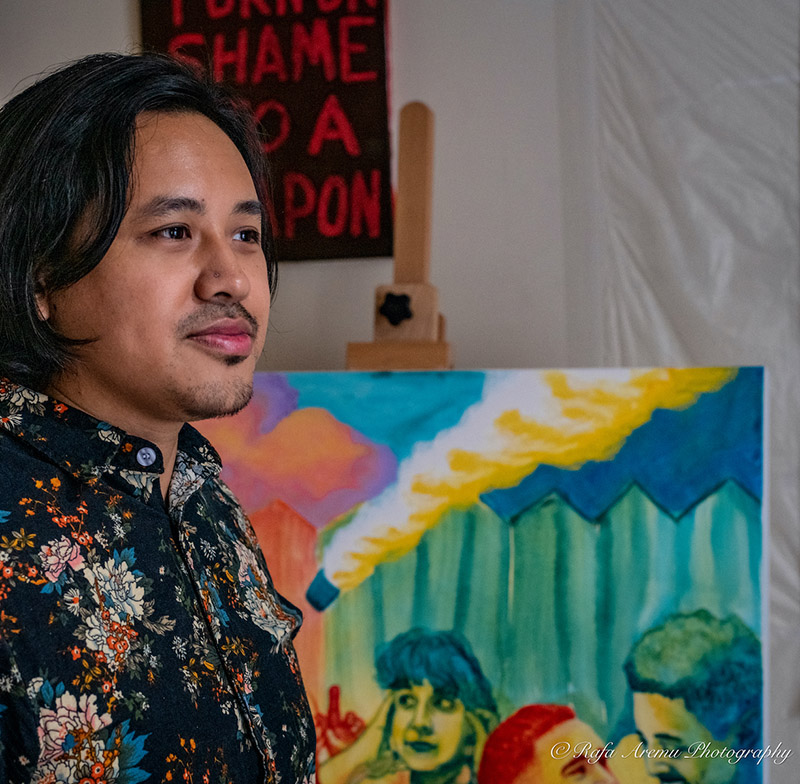10/6/21 with Studio Rami
This article was originally published by Studio Rami in October 2021 and has been reformatted below.
Q. Tell us a bit about yourself and what you do.
I am a visual artist and co-founder of The Model Mutiny clothing line, based in Washington, D.C. My art practice includes painting, drawing and printmaking. Influenced by my landscape architecture education, my work synthesizes narrative, history and place to tell stories about people I admire and reflections on my own life. One of my paintings simply states “Turn UR Shame Into A Weapon.”. This motto is the focus of my current body of work where I consider things that once brought me shame and flip them into a positive affirmation that my experiences were valid and are valuable. I like to think that I’m making art that I needed when I was younger.

Q. What was your formal introduction to art growing up?
My sister has worked at the Hunter Art Museum in Chattanooga, TN since I was young and actually helped me get my first summer job there, working at the front desk. I never had the ability to view art in person on such a regular basis before, and I learned to value time sitting in stillness in front of a painting and noticing how it made me feel.
Q. In your youth, did you foresee a future where you could incorporate your passion into your everyday life?
Drawing has always been part of my life. I remember drawing an astronaut for an art contest in first grade about what I wanted to be when I grew up. Although my space dreams have yet to come true, I certainly wanted to study a field that was related to the arts. As a first generation Vietnamese-American, getting a degree in fine art didn’t seem like a stable choice for me, so I chose a degree in landscape architecture at Penn State University. As I mentioned before, this field utilizes history, narrative and ecology to pinpoint what makes a place special. I’m grateful that this investigative training still shapes how I approach my art practice and the pursuit of layered meanings.

Q. Are there any artists who heavily influenced your style? Which historical artist do you wish upcoming artists/students had more access to their work and why?
Art history is full of painters who don’t look like me, so I really look up to Kerry James Marshall and Hung Liu, who recently passed away this year. Marshall speaks often about filling in the gap of art history that doesn’t show Black faces and experiences, that again are valid and valuable. I also admire Marshall’s ingenuity in mixing colors to create a “blacker” black which can only be noticed in person and not in reproduction. That’s such a cool use of material. Liu taught me that specificity can be universal, so in other words, telling one person’s story in a way that pinpoints what made them special can resonate with other people. Ultimately this search for commonality is what I strive for in my work because I believe that we are all more connected than we may perceive.

Q. In your words, what is art’s role in the rapidly changing world and how are you leaving your mark?
A great artwork forces you to think about a certain issue through the lens of the artist and then back to how you view the world. Within that journey, you can find understanding, commonality and healing.
Growing up in the American South among few who looked like me, I’ve suffered from an identity crisis that brought me shame as an outsider. My work highlights that these unique experiences of vulnerability were valid and are valuable. Negotiating images of Americana and various Asian culture, I paint narrative scenes that sift through history and cultural expectations to reveal complex layers of identity. My paintings examine my evolving attitudes on masculinity, femininity, injustice and identity.
The portraits explore color, light and space to create scenes that are more daydream than reality. The works feature people close to me and public figures I admire to highlight how identity is constantly provoked by internal and external forces. My work asks questions about the Asian American experience, and in that search for commonality, others are welcome to listen in.
I have an upcoming solo painting exhibition in New York in November 2021. You can follow me on Instagram for more info.

